Project Management Portfolio - PPMP20012 Unit, CQ University
VerifiedAdded on 2022/12/29
|14
|3464
|282
Project
AI Summary
This project management portfolio presents a comprehensive overview of project management principles and systems thinking, covering various learning outcomes. The portfolio begins with an introduction to project management challenges and the importance of data collection and task formulation. It delves into the application of systems thinking, exploring strategies for project initiation, including data release, bottom-up estimation, and project management software. The portfolio examines tools and techniques for project managers, such as decision matrices and flow diagrams, illustrated with a case study of McDonald's supply chain. It further discusses systems engineering as a discipline, emphasizing the project manager's role in identifying requirements and generating process flows. The portfolio also covers the use of system engineering concepts and methodologies to organize projects efficiently, manage risks, and select appropriate project management methodologies. It highlights the role of system engineering in decision-making under constraints and the advantages and disadvantages of electronic and manual project management application systems. Finally, the portfolio explores how project management application systems help managers monitor project performance and supervise system development, offering insights for project success.
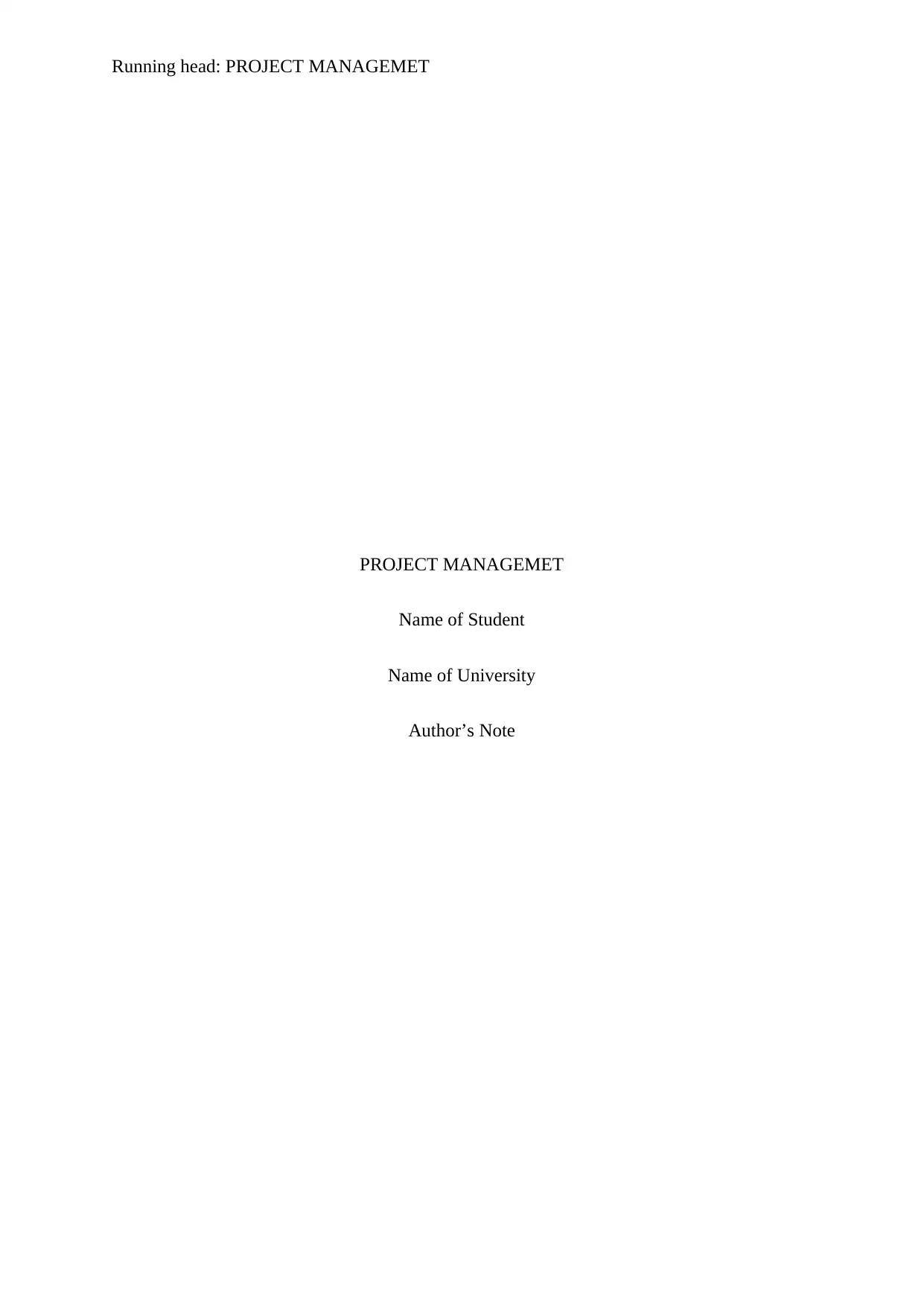
Running head: PROJECT MANAGEMET
PROJECT MANAGEMET
Name of Student
Name of University
Author’s Note
PROJECT MANAGEMET
Name of Student
Name of University
Author’s Note
Paraphrase This Document
Need a fresh take? Get an instant paraphrase of this document with our AI Paraphraser
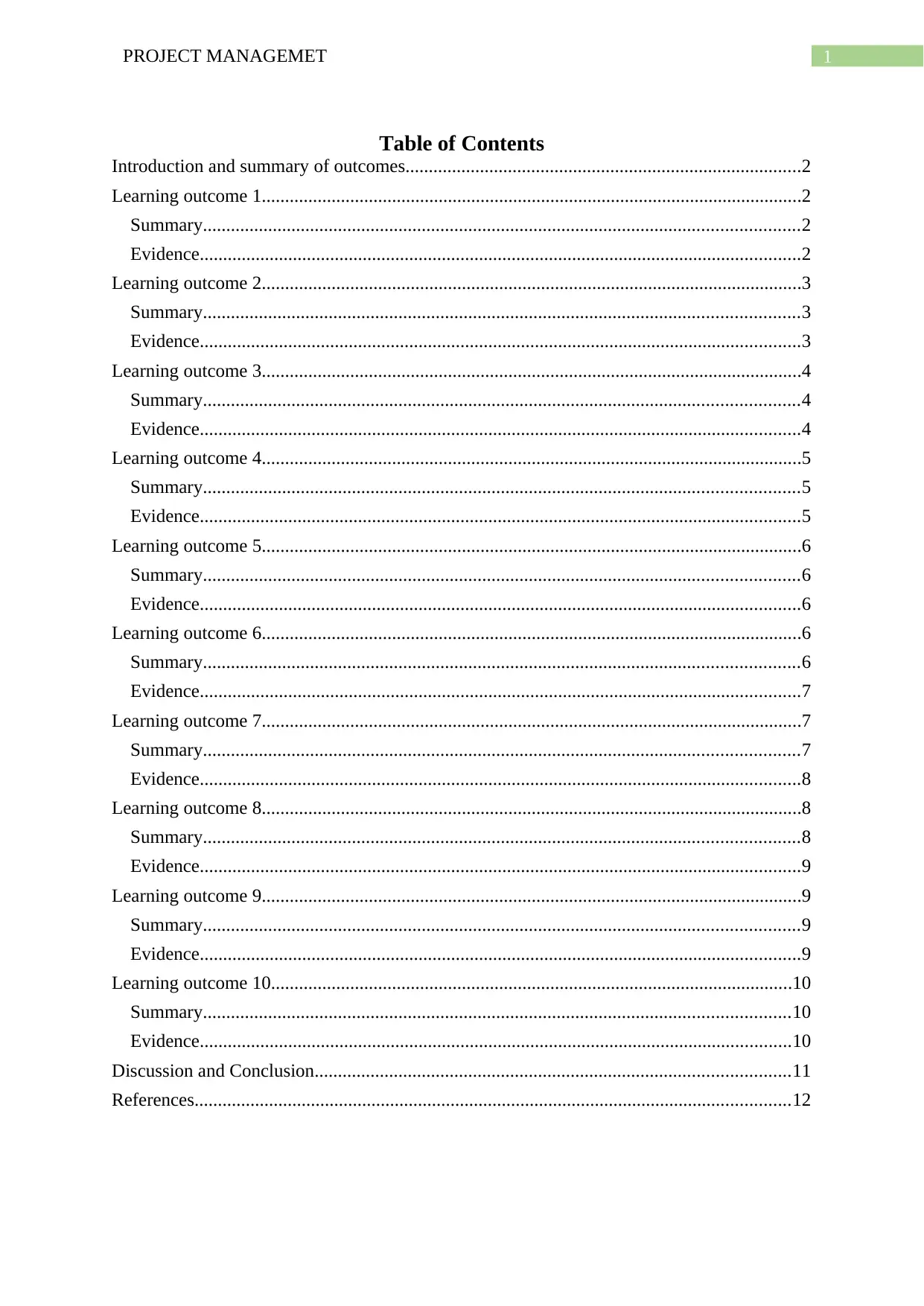
1PROJECT MANAGEMET
Table of Contents
Introduction and summary of outcomes.....................................................................................2
Learning outcome 1....................................................................................................................2
Summary................................................................................................................................2
Evidence.................................................................................................................................2
Learning outcome 2....................................................................................................................3
Summary................................................................................................................................3
Evidence.................................................................................................................................3
Learning outcome 3....................................................................................................................4
Summary................................................................................................................................4
Evidence.................................................................................................................................4
Learning outcome 4....................................................................................................................5
Summary................................................................................................................................5
Evidence.................................................................................................................................5
Learning outcome 5....................................................................................................................6
Summary................................................................................................................................6
Evidence.................................................................................................................................6
Learning outcome 6....................................................................................................................6
Summary................................................................................................................................6
Evidence.................................................................................................................................7
Learning outcome 7....................................................................................................................7
Summary................................................................................................................................7
Evidence.................................................................................................................................8
Learning outcome 8....................................................................................................................8
Summary................................................................................................................................8
Evidence.................................................................................................................................9
Learning outcome 9....................................................................................................................9
Summary................................................................................................................................9
Evidence.................................................................................................................................9
Learning outcome 10................................................................................................................10
Summary..............................................................................................................................10
Evidence...............................................................................................................................10
Discussion and Conclusion......................................................................................................11
References................................................................................................................................12
Table of Contents
Introduction and summary of outcomes.....................................................................................2
Learning outcome 1....................................................................................................................2
Summary................................................................................................................................2
Evidence.................................................................................................................................2
Learning outcome 2....................................................................................................................3
Summary................................................................................................................................3
Evidence.................................................................................................................................3
Learning outcome 3....................................................................................................................4
Summary................................................................................................................................4
Evidence.................................................................................................................................4
Learning outcome 4....................................................................................................................5
Summary................................................................................................................................5
Evidence.................................................................................................................................5
Learning outcome 5....................................................................................................................6
Summary................................................................................................................................6
Evidence.................................................................................................................................6
Learning outcome 6....................................................................................................................6
Summary................................................................................................................................6
Evidence.................................................................................................................................7
Learning outcome 7....................................................................................................................7
Summary................................................................................................................................7
Evidence.................................................................................................................................8
Learning outcome 8....................................................................................................................8
Summary................................................................................................................................8
Evidence.................................................................................................................................9
Learning outcome 9....................................................................................................................9
Summary................................................................................................................................9
Evidence.................................................................................................................................9
Learning outcome 10................................................................................................................10
Summary..............................................................................................................................10
Evidence...............................................................................................................................10
Discussion and Conclusion......................................................................................................11
References................................................................................................................................12
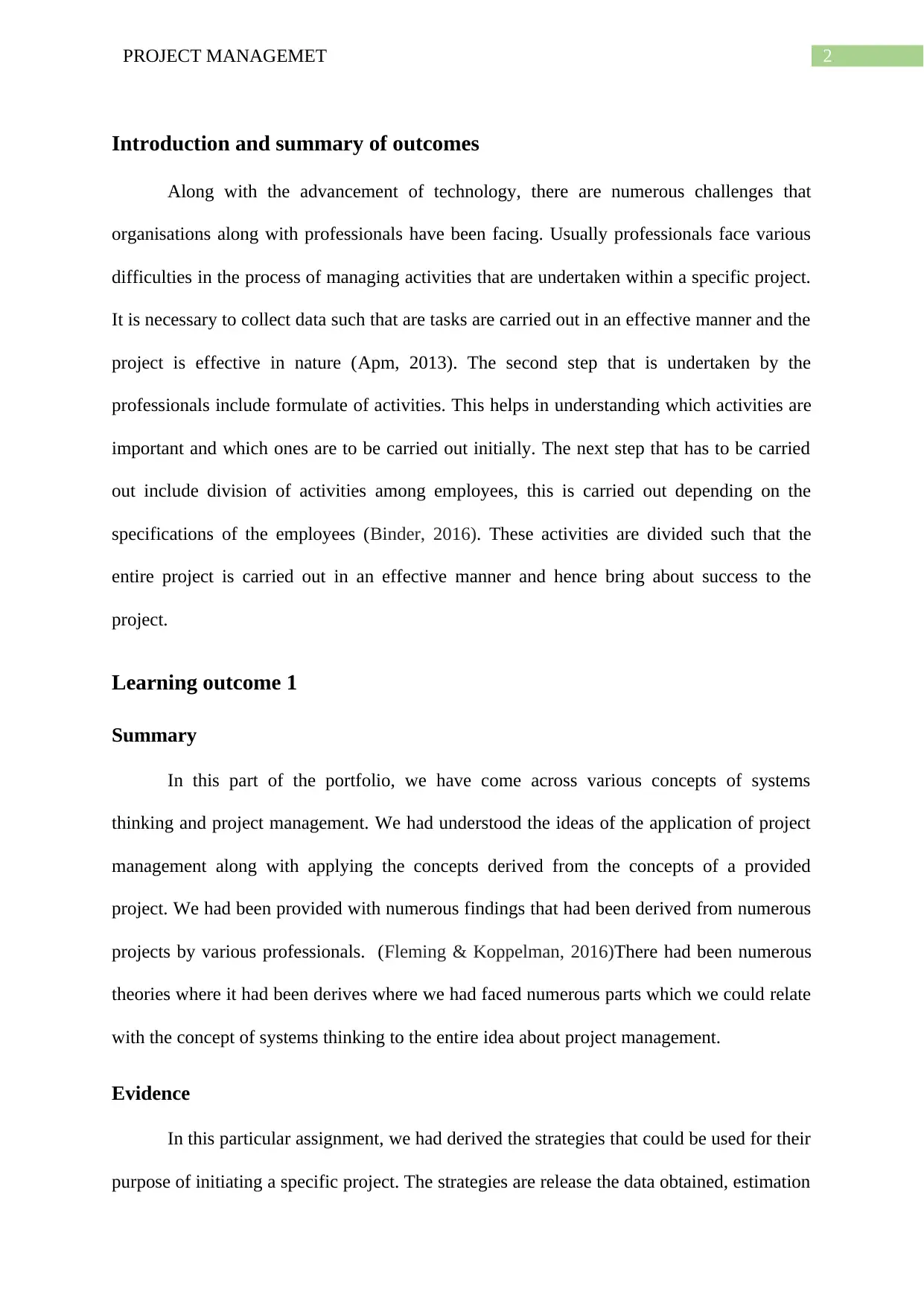
2PROJECT MANAGEMET
Introduction and summary of outcomes
Along with the advancement of technology, there are numerous challenges that
organisations along with professionals have been facing. Usually professionals face various
difficulties in the process of managing activities that are undertaken within a specific project.
It is necessary to collect data such that are tasks are carried out in an effective manner and the
project is effective in nature (Apm, 2013). The second step that is undertaken by the
professionals include formulate of activities. This helps in understanding which activities are
important and which ones are to be carried out initially. The next step that has to be carried
out include division of activities among employees, this is carried out depending on the
specifications of the employees (Binder, 2016). These activities are divided such that the
entire project is carried out in an effective manner and hence bring about success to the
project.
Learning outcome 1
Summary
In this part of the portfolio, we have come across various concepts of systems
thinking and project management. We had understood the ideas of the application of project
management along with applying the concepts derived from the concepts of a provided
project. We had been provided with numerous findings that had been derived from numerous
projects by various professionals. (Fleming & Koppelman, 2016)There had been numerous
theories where it had been derives where we had faced numerous parts which we could relate
with the concept of systems thinking to the entire idea about project management.
Evidence
In this particular assignment, we had derived the strategies that could be used for their
purpose of initiating a specific project. The strategies are release the data obtained, estimation
Introduction and summary of outcomes
Along with the advancement of technology, there are numerous challenges that
organisations along with professionals have been facing. Usually professionals face various
difficulties in the process of managing activities that are undertaken within a specific project.
It is necessary to collect data such that are tasks are carried out in an effective manner and the
project is effective in nature (Apm, 2013). The second step that is undertaken by the
professionals include formulate of activities. This helps in understanding which activities are
important and which ones are to be carried out initially. The next step that has to be carried
out include division of activities among employees, this is carried out depending on the
specifications of the employees (Binder, 2016). These activities are divided such that the
entire project is carried out in an effective manner and hence bring about success to the
project.
Learning outcome 1
Summary
In this part of the portfolio, we have come across various concepts of systems
thinking and project management. We had understood the ideas of the application of project
management along with applying the concepts derived from the concepts of a provided
project. We had been provided with numerous findings that had been derived from numerous
projects by various professionals. (Fleming & Koppelman, 2016)There had been numerous
theories where it had been derives where we had faced numerous parts which we could relate
with the concept of systems thinking to the entire idea about project management.
Evidence
In this particular assignment, we had derived the strategies that could be used for their
purpose of initiating a specific project. The strategies are release the data obtained, estimation
⊘ This is a preview!⊘
Do you want full access?
Subscribe today to unlock all pages.

Trusted by 1+ million students worldwide
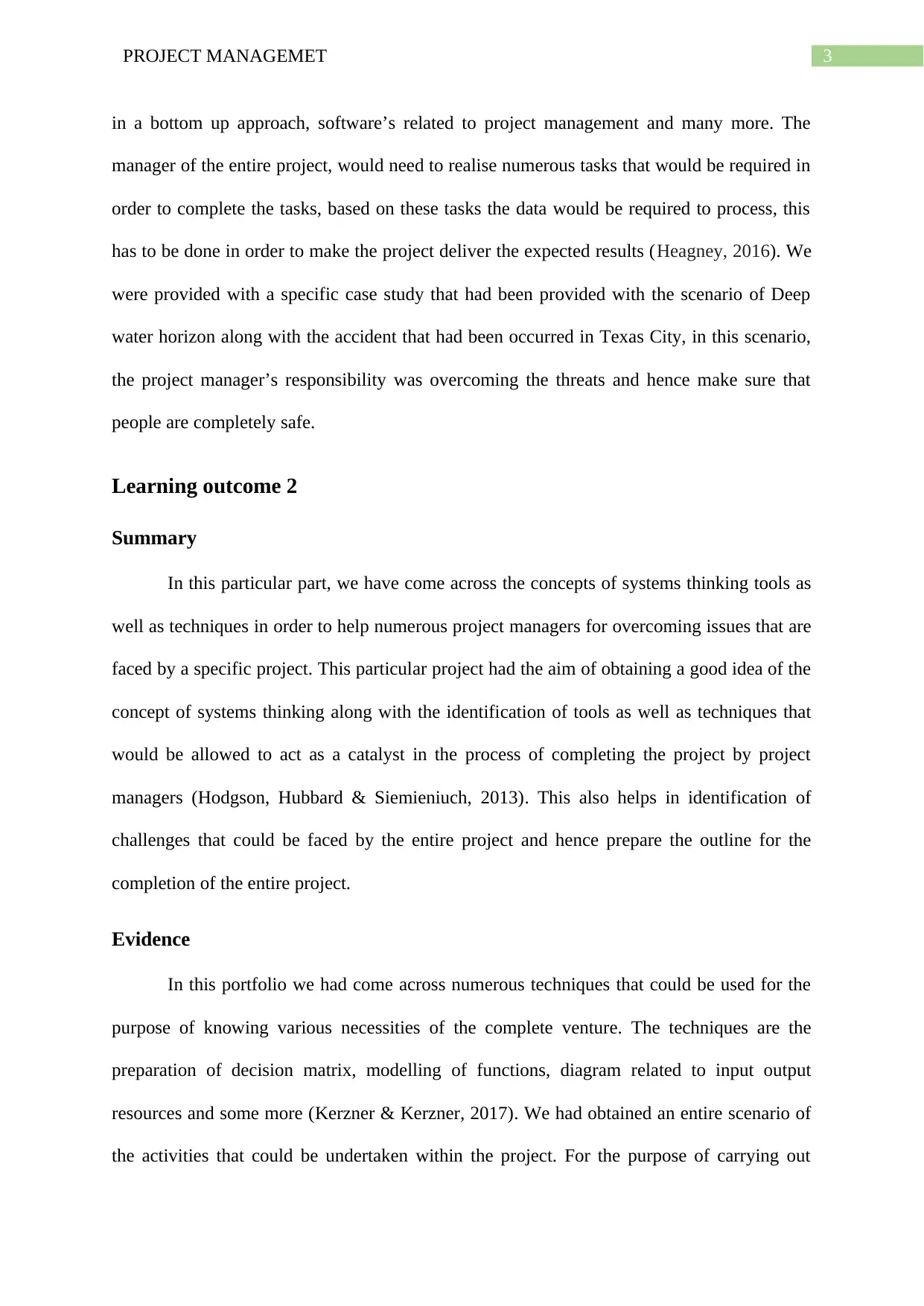
3PROJECT MANAGEMET
in a bottom up approach, software’s related to project management and many more. The
manager of the entire project, would need to realise numerous tasks that would be required in
order to complete the tasks, based on these tasks the data would be required to process, this
has to be done in order to make the project deliver the expected results (Heagney, 2016). We
were provided with a specific case study that had been provided with the scenario of Deep
water horizon along with the accident that had been occurred in Texas City, in this scenario,
the project manager’s responsibility was overcoming the threats and hence make sure that
people are completely safe.
Learning outcome 2
Summary
In this particular part, we have come across the concepts of systems thinking tools as
well as techniques in order to help numerous project managers for overcoming issues that are
faced by a specific project. This particular project had the aim of obtaining a good idea of the
concept of systems thinking along with the identification of tools as well as techniques that
would be allowed to act as a catalyst in the process of completing the project by project
managers (Hodgson, Hubbard & Siemieniuch, 2013). This also helps in identification of
challenges that could be faced by the entire project and hence prepare the outline for the
completion of the entire project.
Evidence
In this portfolio we had come across numerous techniques that could be used for the
purpose of knowing various necessities of the complete venture. The techniques are the
preparation of decision matrix, modelling of functions, diagram related to input output
resources and some more (Kerzner & Kerzner, 2017). We had obtained an entire scenario of
the activities that could be undertaken within the project. For the purpose of carrying out
in a bottom up approach, software’s related to project management and many more. The
manager of the entire project, would need to realise numerous tasks that would be required in
order to complete the tasks, based on these tasks the data would be required to process, this
has to be done in order to make the project deliver the expected results (Heagney, 2016). We
were provided with a specific case study that had been provided with the scenario of Deep
water horizon along with the accident that had been occurred in Texas City, in this scenario,
the project manager’s responsibility was overcoming the threats and hence make sure that
people are completely safe.
Learning outcome 2
Summary
In this particular part, we have come across the concepts of systems thinking tools as
well as techniques in order to help numerous project managers for overcoming issues that are
faced by a specific project. This particular project had the aim of obtaining a good idea of the
concept of systems thinking along with the identification of tools as well as techniques that
would be allowed to act as a catalyst in the process of completing the project by project
managers (Hodgson, Hubbard & Siemieniuch, 2013). This also helps in identification of
challenges that could be faced by the entire project and hence prepare the outline for the
completion of the entire project.
Evidence
In this portfolio we had come across numerous techniques that could be used for the
purpose of knowing various necessities of the complete venture. The techniques are the
preparation of decision matrix, modelling of functions, diagram related to input output
resources and some more (Kerzner & Kerzner, 2017). We had obtained an entire scenario of
the activities that could be undertaken within the project. For the purpose of carrying out
Paraphrase This Document
Need a fresh take? Get an instant paraphrase of this document with our AI Paraphraser
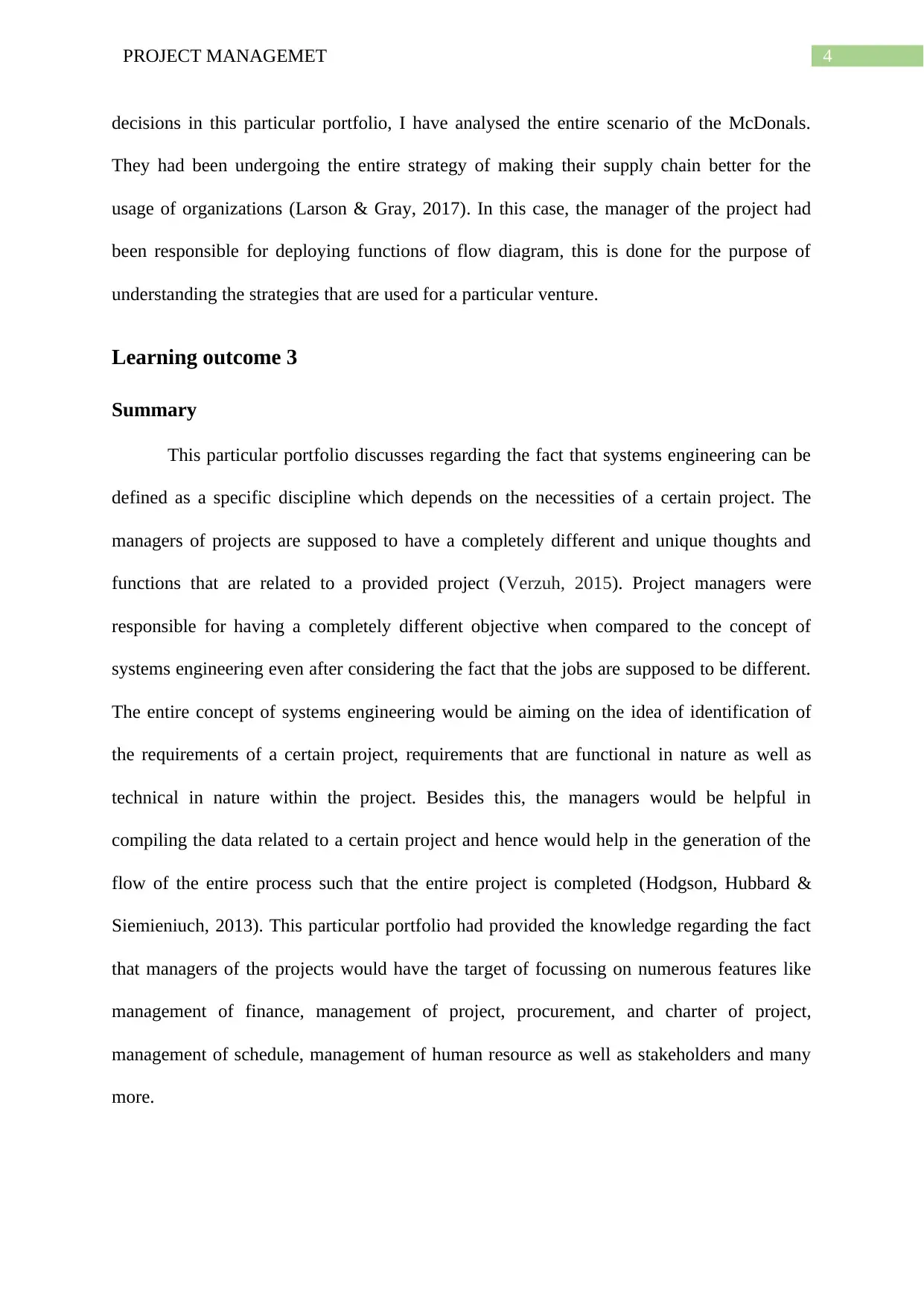
4PROJECT MANAGEMET
decisions in this particular portfolio, I have analysed the entire scenario of the McDonals.
They had been undergoing the entire strategy of making their supply chain better for the
usage of organizations (Larson & Gray, 2017). In this case, the manager of the project had
been responsible for deploying functions of flow diagram, this is done for the purpose of
understanding the strategies that are used for a particular venture.
Learning outcome 3
Summary
This particular portfolio discusses regarding the fact that systems engineering can be
defined as a specific discipline which depends on the necessities of a certain project. The
managers of projects are supposed to have a completely different and unique thoughts and
functions that are related to a provided project (Verzuh, 2015). Project managers were
responsible for having a completely different objective when compared to the concept of
systems engineering even after considering the fact that the jobs are supposed to be different.
The entire concept of systems engineering would be aiming on the idea of identification of
the requirements of a certain project, requirements that are functional in nature as well as
technical in nature within the project. Besides this, the managers would be helpful in
compiling the data related to a certain project and hence would help in the generation of the
flow of the entire process such that the entire project is completed (Hodgson, Hubbard &
Siemieniuch, 2013). This particular portfolio had provided the knowledge regarding the fact
that managers of the projects would have the target of focussing on numerous features like
management of finance, management of project, procurement, and charter of project,
management of schedule, management of human resource as well as stakeholders and many
more.
decisions in this particular portfolio, I have analysed the entire scenario of the McDonals.
They had been undergoing the entire strategy of making their supply chain better for the
usage of organizations (Larson & Gray, 2017). In this case, the manager of the project had
been responsible for deploying functions of flow diagram, this is done for the purpose of
understanding the strategies that are used for a particular venture.
Learning outcome 3
Summary
This particular portfolio discusses regarding the fact that systems engineering can be
defined as a specific discipline which depends on the necessities of a certain project. The
managers of projects are supposed to have a completely different and unique thoughts and
functions that are related to a provided project (Verzuh, 2015). Project managers were
responsible for having a completely different objective when compared to the concept of
systems engineering even after considering the fact that the jobs are supposed to be different.
The entire concept of systems engineering would be aiming on the idea of identification of
the requirements of a certain project, requirements that are functional in nature as well as
technical in nature within the project. Besides this, the managers would be helpful in
compiling the data related to a certain project and hence would help in the generation of the
flow of the entire process such that the entire project is completed (Hodgson, Hubbard &
Siemieniuch, 2013). This particular portfolio had provided the knowledge regarding the fact
that managers of the projects would have the target of focussing on numerous features like
management of finance, management of project, procurement, and charter of project,
management of schedule, management of human resource as well as stakeholders and many
more.
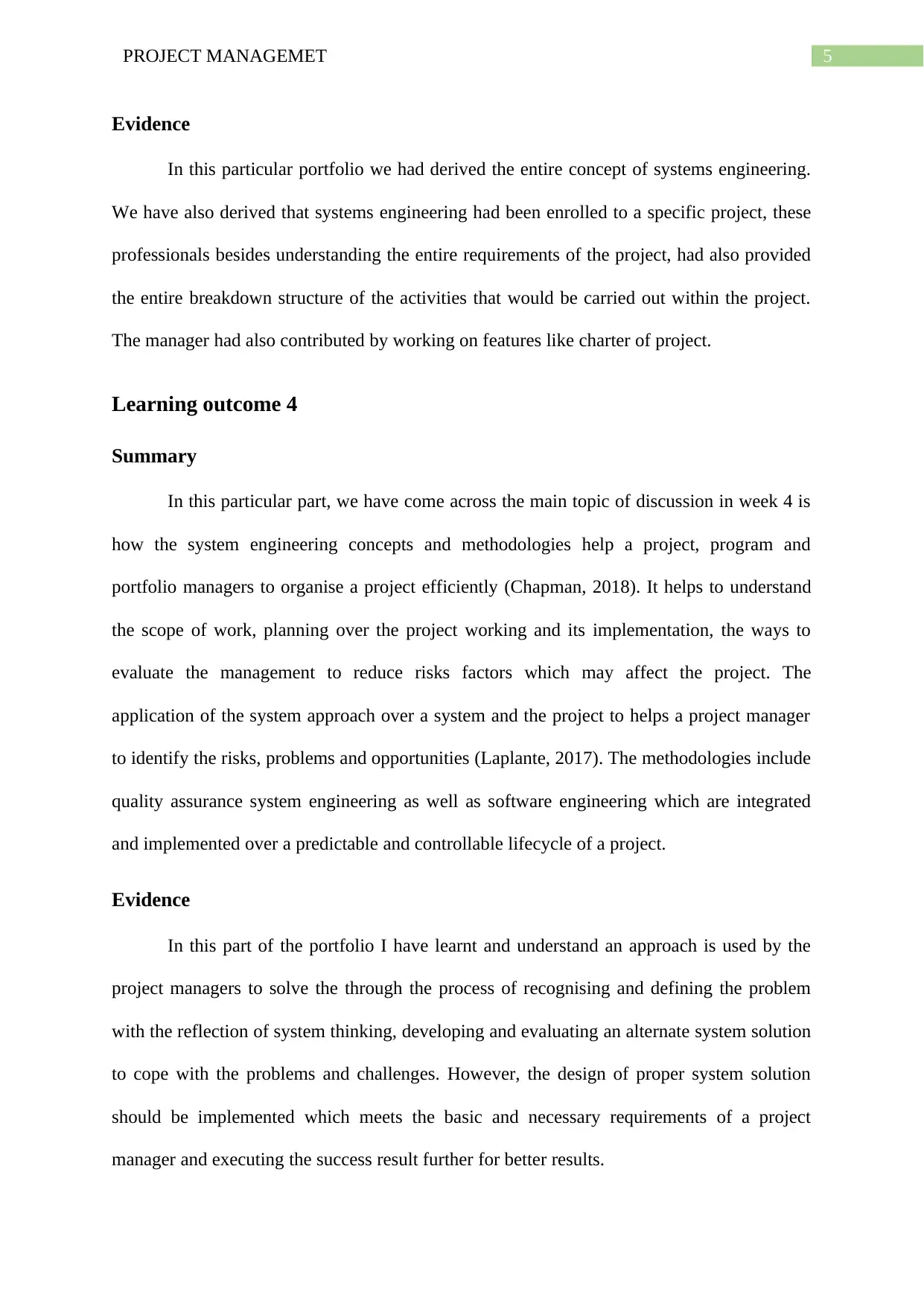
5PROJECT MANAGEMET
Evidence
In this particular portfolio we had derived the entire concept of systems engineering.
We have also derived that systems engineering had been enrolled to a specific project, these
professionals besides understanding the entire requirements of the project, had also provided
the entire breakdown structure of the activities that would be carried out within the project.
The manager had also contributed by working on features like charter of project.
Learning outcome 4
Summary
In this particular part, we have come across the main topic of discussion in week 4 is
how the system engineering concepts and methodologies help a project, program and
portfolio managers to organise a project efficiently (Chapman, 2018). It helps to understand
the scope of work, planning over the project working and its implementation, the ways to
evaluate the management to reduce risks factors which may affect the project. The
application of the system approach over a system and the project to helps a project manager
to identify the risks, problems and opportunities (Laplante, 2017). The methodologies include
quality assurance system engineering as well as software engineering which are integrated
and implemented over a predictable and controllable lifecycle of a project.
Evidence
In this part of the portfolio I have learnt and understand an approach is used by the
project managers to solve the through the process of recognising and defining the problem
with the reflection of system thinking, developing and evaluating an alternate system solution
to cope with the problems and challenges. However, the design of proper system solution
should be implemented which meets the basic and necessary requirements of a project
manager and executing the success result further for better results.
Evidence
In this particular portfolio we had derived the entire concept of systems engineering.
We have also derived that systems engineering had been enrolled to a specific project, these
professionals besides understanding the entire requirements of the project, had also provided
the entire breakdown structure of the activities that would be carried out within the project.
The manager had also contributed by working on features like charter of project.
Learning outcome 4
Summary
In this particular part, we have come across the main topic of discussion in week 4 is
how the system engineering concepts and methodologies help a project, program and
portfolio managers to organise a project efficiently (Chapman, 2018). It helps to understand
the scope of work, planning over the project working and its implementation, the ways to
evaluate the management to reduce risks factors which may affect the project. The
application of the system approach over a system and the project to helps a project manager
to identify the risks, problems and opportunities (Laplante, 2017). The methodologies include
quality assurance system engineering as well as software engineering which are integrated
and implemented over a predictable and controllable lifecycle of a project.
Evidence
In this part of the portfolio I have learnt and understand an approach is used by the
project managers to solve the through the process of recognising and defining the problem
with the reflection of system thinking, developing and evaluating an alternate system solution
to cope with the problems and challenges. However, the design of proper system solution
should be implemented which meets the basic and necessary requirements of a project
manager and executing the success result further for better results.
⊘ This is a preview!⊘
Do you want full access?
Subscribe today to unlock all pages.

Trusted by 1+ million students worldwide
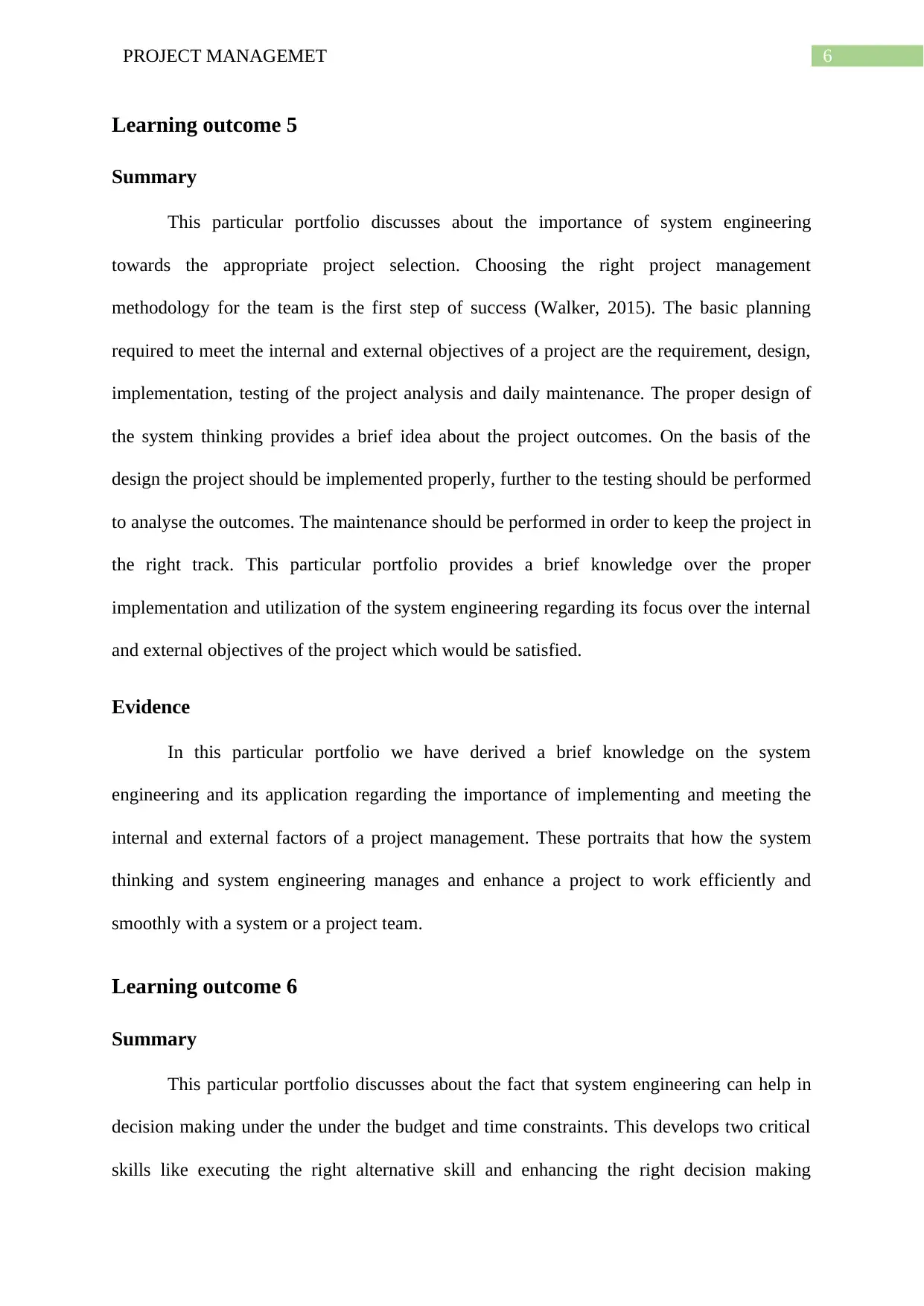
6PROJECT MANAGEMET
Learning outcome 5
Summary
This particular portfolio discusses about the importance of system engineering
towards the appropriate project selection. Choosing the right project management
methodology for the team is the first step of success (Walker, 2015). The basic planning
required to meet the internal and external objectives of a project are the requirement, design,
implementation, testing of the project analysis and daily maintenance. The proper design of
the system thinking provides a brief idea about the project outcomes. On the basis of the
design the project should be implemented properly, further to the testing should be performed
to analyse the outcomes. The maintenance should be performed in order to keep the project in
the right track. This particular portfolio provides a brief knowledge over the proper
implementation and utilization of the system engineering regarding its focus over the internal
and external objectives of the project which would be satisfied.
Evidence
In this particular portfolio we have derived a brief knowledge on the system
engineering and its application regarding the importance of implementing and meeting the
internal and external factors of a project management. These portraits that how the system
thinking and system engineering manages and enhance a project to work efficiently and
smoothly with a system or a project team.
Learning outcome 6
Summary
This particular portfolio discusses about the fact that system engineering can help in
decision making under the under the budget and time constraints. This develops two critical
skills like executing the right alternative skill and enhancing the right decision making
Learning outcome 5
Summary
This particular portfolio discusses about the importance of system engineering
towards the appropriate project selection. Choosing the right project management
methodology for the team is the first step of success (Walker, 2015). The basic planning
required to meet the internal and external objectives of a project are the requirement, design,
implementation, testing of the project analysis and daily maintenance. The proper design of
the system thinking provides a brief idea about the project outcomes. On the basis of the
design the project should be implemented properly, further to the testing should be performed
to analyse the outcomes. The maintenance should be performed in order to keep the project in
the right track. This particular portfolio provides a brief knowledge over the proper
implementation and utilization of the system engineering regarding its focus over the internal
and external objectives of the project which would be satisfied.
Evidence
In this particular portfolio we have derived a brief knowledge on the system
engineering and its application regarding the importance of implementing and meeting the
internal and external factors of a project management. These portraits that how the system
thinking and system engineering manages and enhance a project to work efficiently and
smoothly with a system or a project team.
Learning outcome 6
Summary
This particular portfolio discusses about the fact that system engineering can help in
decision making under the under the budget and time constraints. This develops two critical
skills like executing the right alternative skill and enhancing the right decision making
Paraphrase This Document
Need a fresh take? Get an instant paraphrase of this document with our AI Paraphraser
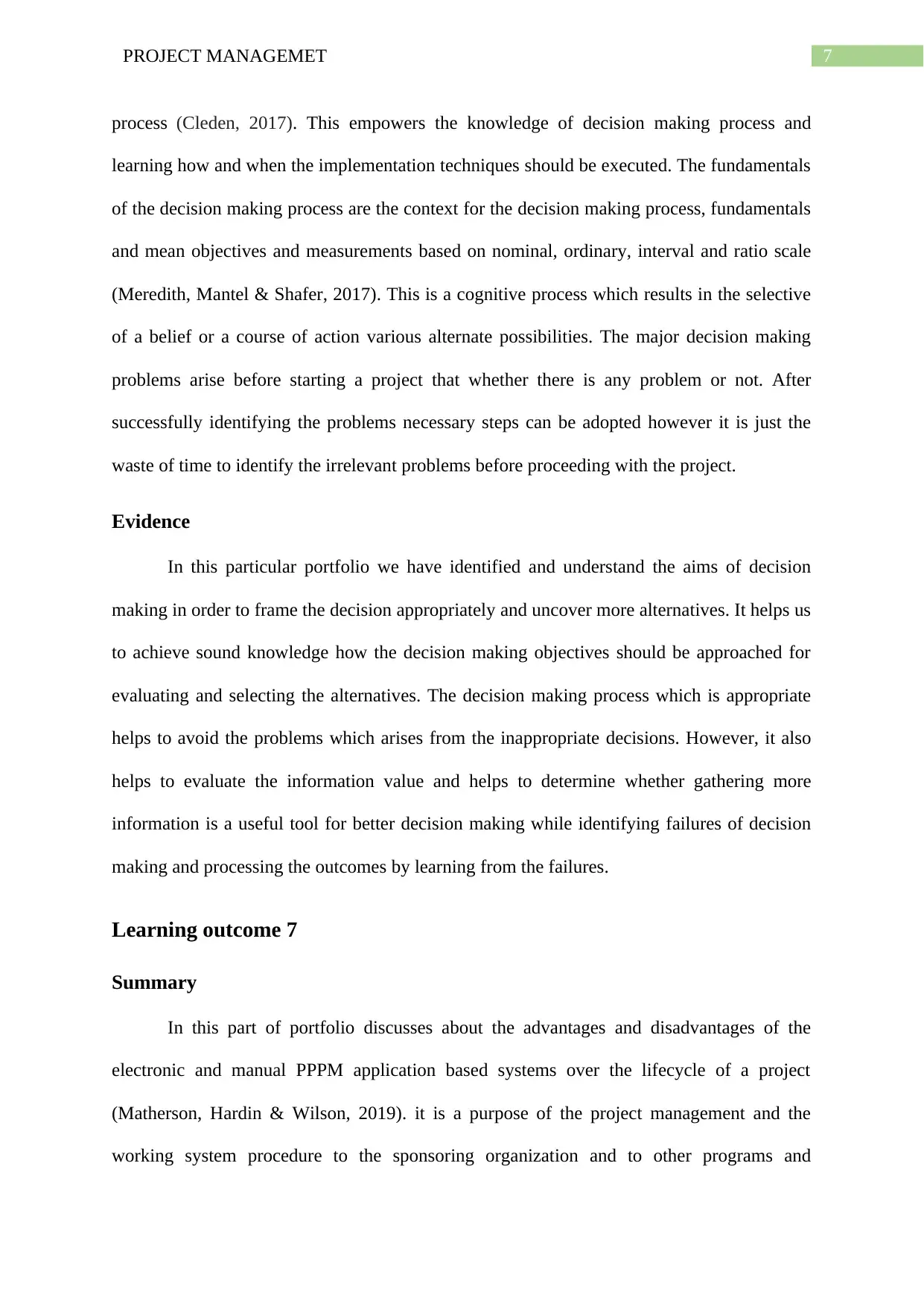
7PROJECT MANAGEMET
process (Cleden, 2017). This empowers the knowledge of decision making process and
learning how and when the implementation techniques should be executed. The fundamentals
of the decision making process are the context for the decision making process, fundamentals
and mean objectives and measurements based on nominal, ordinary, interval and ratio scale
(Meredith, Mantel & Shafer, 2017). This is a cognitive process which results in the selective
of a belief or a course of action various alternate possibilities. The major decision making
problems arise before starting a project that whether there is any problem or not. After
successfully identifying the problems necessary steps can be adopted however it is just the
waste of time to identify the irrelevant problems before proceeding with the project.
Evidence
In this particular portfolio we have identified and understand the aims of decision
making in order to frame the decision appropriately and uncover more alternatives. It helps us
to achieve sound knowledge how the decision making objectives should be approached for
evaluating and selecting the alternatives. The decision making process which is appropriate
helps to avoid the problems which arises from the inappropriate decisions. However, it also
helps to evaluate the information value and helps to determine whether gathering more
information is a useful tool for better decision making while identifying failures of decision
making and processing the outcomes by learning from the failures.
Learning outcome 7
Summary
In this part of portfolio discusses about the advantages and disadvantages of the
electronic and manual PPPM application based systems over the lifecycle of a project
(Matherson, Hardin & Wilson, 2019). it is a purpose of the project management and the
working system procedure to the sponsoring organization and to other programs and
process (Cleden, 2017). This empowers the knowledge of decision making process and
learning how and when the implementation techniques should be executed. The fundamentals
of the decision making process are the context for the decision making process, fundamentals
and mean objectives and measurements based on nominal, ordinary, interval and ratio scale
(Meredith, Mantel & Shafer, 2017). This is a cognitive process which results in the selective
of a belief or a course of action various alternate possibilities. The major decision making
problems arise before starting a project that whether there is any problem or not. After
successfully identifying the problems necessary steps can be adopted however it is just the
waste of time to identify the irrelevant problems before proceeding with the project.
Evidence
In this particular portfolio we have identified and understand the aims of decision
making in order to frame the decision appropriately and uncover more alternatives. It helps us
to achieve sound knowledge how the decision making objectives should be approached for
evaluating and selecting the alternatives. The decision making process which is appropriate
helps to avoid the problems which arises from the inappropriate decisions. However, it also
helps to evaluate the information value and helps to determine whether gathering more
information is a useful tool for better decision making while identifying failures of decision
making and processing the outcomes by learning from the failures.
Learning outcome 7
Summary
In this part of portfolio discusses about the advantages and disadvantages of the
electronic and manual PPPM application based systems over the lifecycle of a project
(Matherson, Hardin & Wilson, 2019). it is a purpose of the project management and the
working system procedure to the sponsoring organization and to other programs and
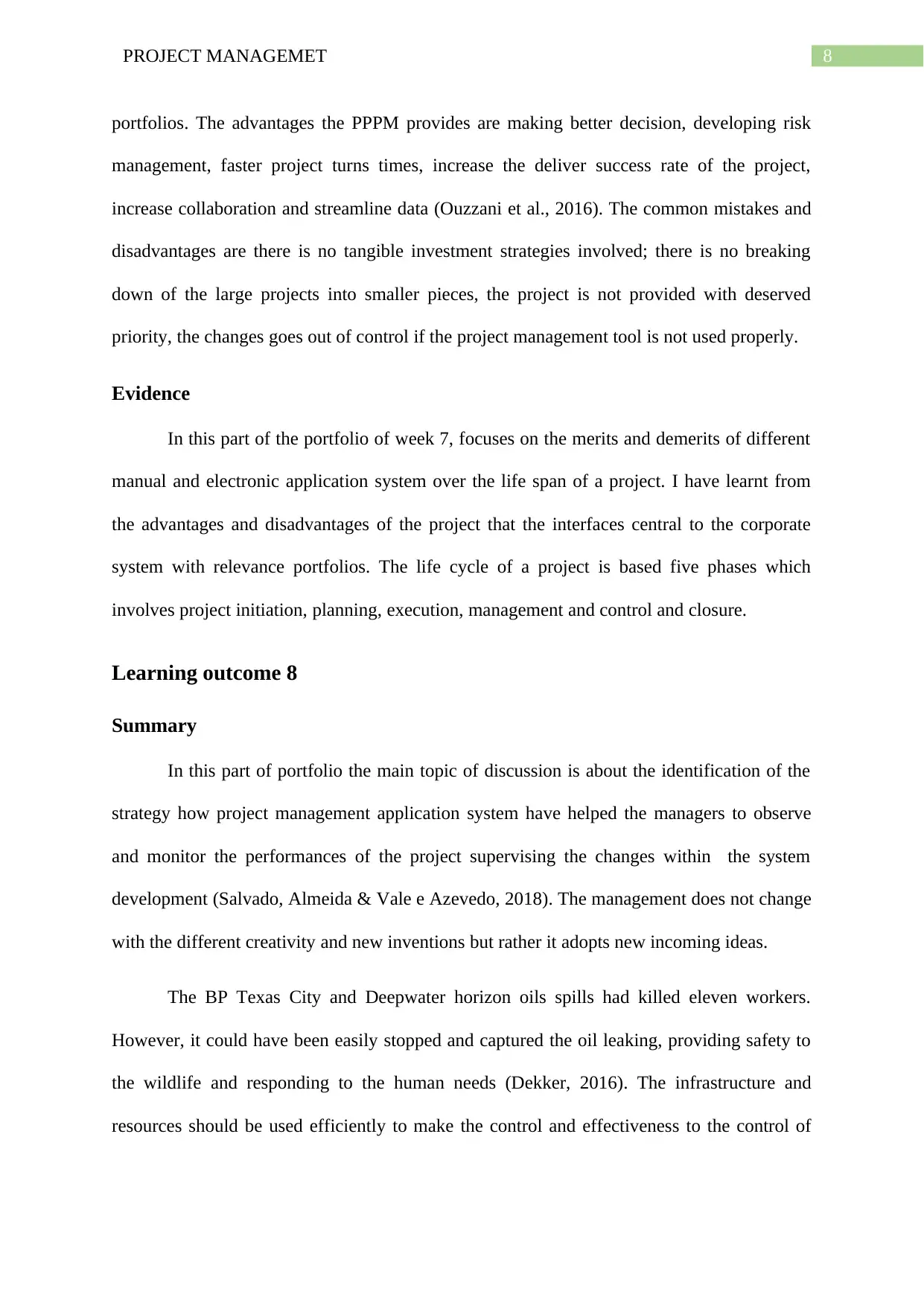
8PROJECT MANAGEMET
portfolios. The advantages the PPPM provides are making better decision, developing risk
management, faster project turns times, increase the deliver success rate of the project,
increase collaboration and streamline data (Ouzzani et al., 2016). The common mistakes and
disadvantages are there is no tangible investment strategies involved; there is no breaking
down of the large projects into smaller pieces, the project is not provided with deserved
priority, the changes goes out of control if the project management tool is not used properly.
Evidence
In this part of the portfolio of week 7, focuses on the merits and demerits of different
manual and electronic application system over the life span of a project. I have learnt from
the advantages and disadvantages of the project that the interfaces central to the corporate
system with relevance portfolios. The life cycle of a project is based five phases which
involves project initiation, planning, execution, management and control and closure.
Learning outcome 8
Summary
In this part of portfolio the main topic of discussion is about the identification of the
strategy how project management application system have helped the managers to observe
and monitor the performances of the project supervising the changes within the system
development (Salvado, Almeida & Vale e Azevedo, 2018). The management does not change
with the different creativity and new inventions but rather it adopts new incoming ideas.
The BP Texas City and Deepwater horizon oils spills had killed eleven workers.
However, it could have been easily stopped and captured the oil leaking, providing safety to
the wildlife and responding to the human needs (Dekker, 2016). The infrastructure and
resources should be used efficiently to make the control and effectiveness to the control of
portfolios. The advantages the PPPM provides are making better decision, developing risk
management, faster project turns times, increase the deliver success rate of the project,
increase collaboration and streamline data (Ouzzani et al., 2016). The common mistakes and
disadvantages are there is no tangible investment strategies involved; there is no breaking
down of the large projects into smaller pieces, the project is not provided with deserved
priority, the changes goes out of control if the project management tool is not used properly.
Evidence
In this part of the portfolio of week 7, focuses on the merits and demerits of different
manual and electronic application system over the life span of a project. I have learnt from
the advantages and disadvantages of the project that the interfaces central to the corporate
system with relevance portfolios. The life cycle of a project is based five phases which
involves project initiation, planning, execution, management and control and closure.
Learning outcome 8
Summary
In this part of portfolio the main topic of discussion is about the identification of the
strategy how project management application system have helped the managers to observe
and monitor the performances of the project supervising the changes within the system
development (Salvado, Almeida & Vale e Azevedo, 2018). The management does not change
with the different creativity and new inventions but rather it adopts new incoming ideas.
The BP Texas City and Deepwater horizon oils spills had killed eleven workers.
However, it could have been easily stopped and captured the oil leaking, providing safety to
the wildlife and responding to the human needs (Dekker, 2016). The infrastructure and
resources should be used efficiently to make the control and effectiveness to the control of
⊘ This is a preview!⊘
Do you want full access?
Subscribe today to unlock all pages.

Trusted by 1+ million students worldwide
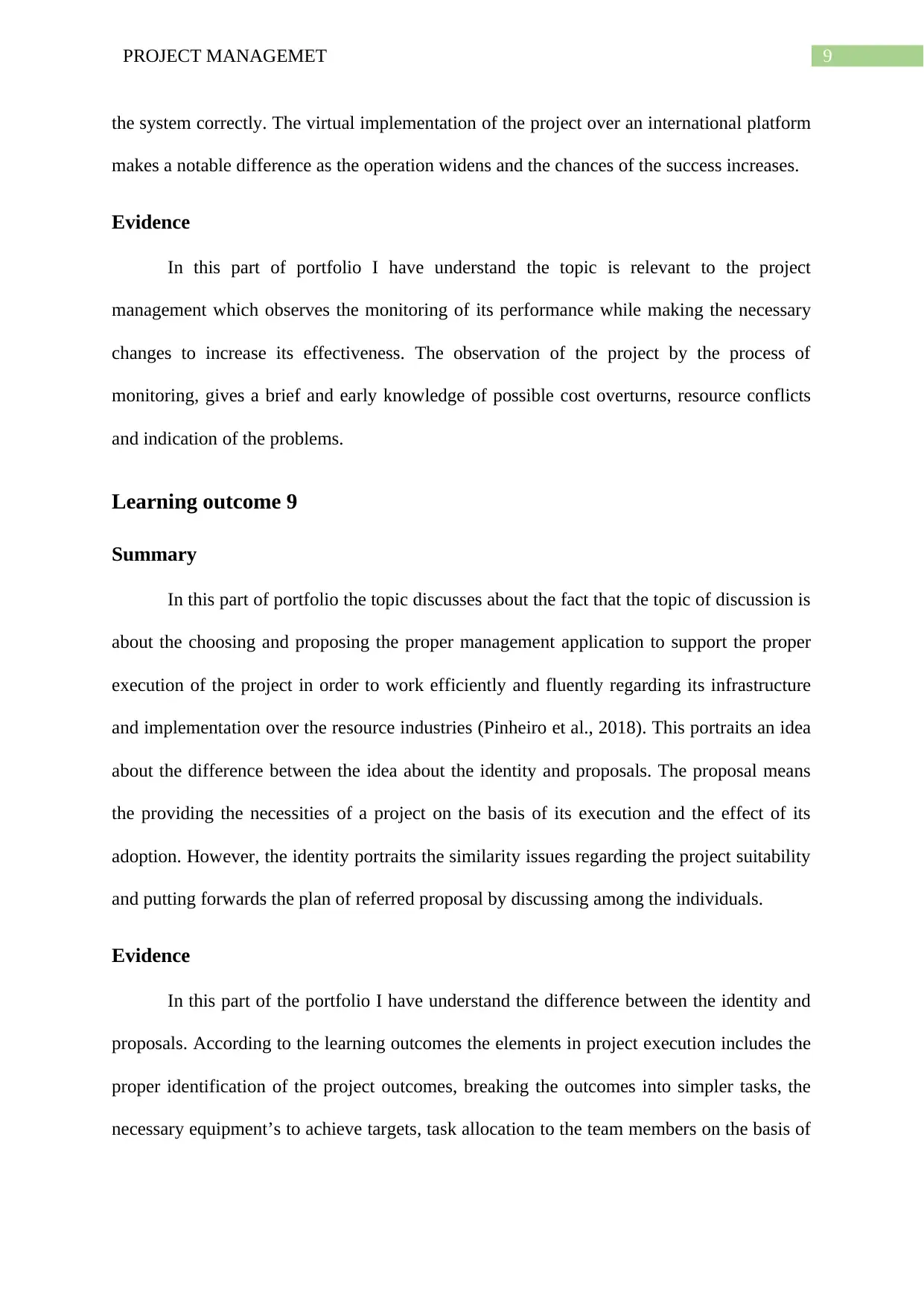
9PROJECT MANAGEMET
the system correctly. The virtual implementation of the project over an international platform
makes a notable difference as the operation widens and the chances of the success increases.
Evidence
In this part of portfolio I have understand the topic is relevant to the project
management which observes the monitoring of its performance while making the necessary
changes to increase its effectiveness. The observation of the project by the process of
monitoring, gives a brief and early knowledge of possible cost overturns, resource conflicts
and indication of the problems.
Learning outcome 9
Summary
In this part of portfolio the topic discusses about the fact that the topic of discussion is
about the choosing and proposing the proper management application to support the proper
execution of the project in order to work efficiently and fluently regarding its infrastructure
and implementation over the resource industries (Pinheiro et al., 2018). This portraits an idea
about the difference between the idea about the identity and proposals. The proposal means
the providing the necessities of a project on the basis of its execution and the effect of its
adoption. However, the identity portraits the similarity issues regarding the project suitability
and putting forwards the plan of referred proposal by discussing among the individuals.
Evidence
In this part of the portfolio I have understand the difference between the identity and
proposals. According to the learning outcomes the elements in project execution includes the
proper identification of the project outcomes, breaking the outcomes into simpler tasks, the
necessary equipment’s to achieve targets, task allocation to the team members on the basis of
the system correctly. The virtual implementation of the project over an international platform
makes a notable difference as the operation widens and the chances of the success increases.
Evidence
In this part of portfolio I have understand the topic is relevant to the project
management which observes the monitoring of its performance while making the necessary
changes to increase its effectiveness. The observation of the project by the process of
monitoring, gives a brief and early knowledge of possible cost overturns, resource conflicts
and indication of the problems.
Learning outcome 9
Summary
In this part of portfolio the topic discusses about the fact that the topic of discussion is
about the choosing and proposing the proper management application to support the proper
execution of the project in order to work efficiently and fluently regarding its infrastructure
and implementation over the resource industries (Pinheiro et al., 2018). This portraits an idea
about the difference between the idea about the identity and proposals. The proposal means
the providing the necessities of a project on the basis of its execution and the effect of its
adoption. However, the identity portraits the similarity issues regarding the project suitability
and putting forwards the plan of referred proposal by discussing among the individuals.
Evidence
In this part of the portfolio I have understand the difference between the identity and
proposals. According to the learning outcomes the elements in project execution includes the
proper identification of the project outcomes, breaking the outcomes into simpler tasks, the
necessary equipment’s to achieve targets, task allocation to the team members on the basis of
Paraphrase This Document
Need a fresh take? Get an instant paraphrase of this document with our AI Paraphraser
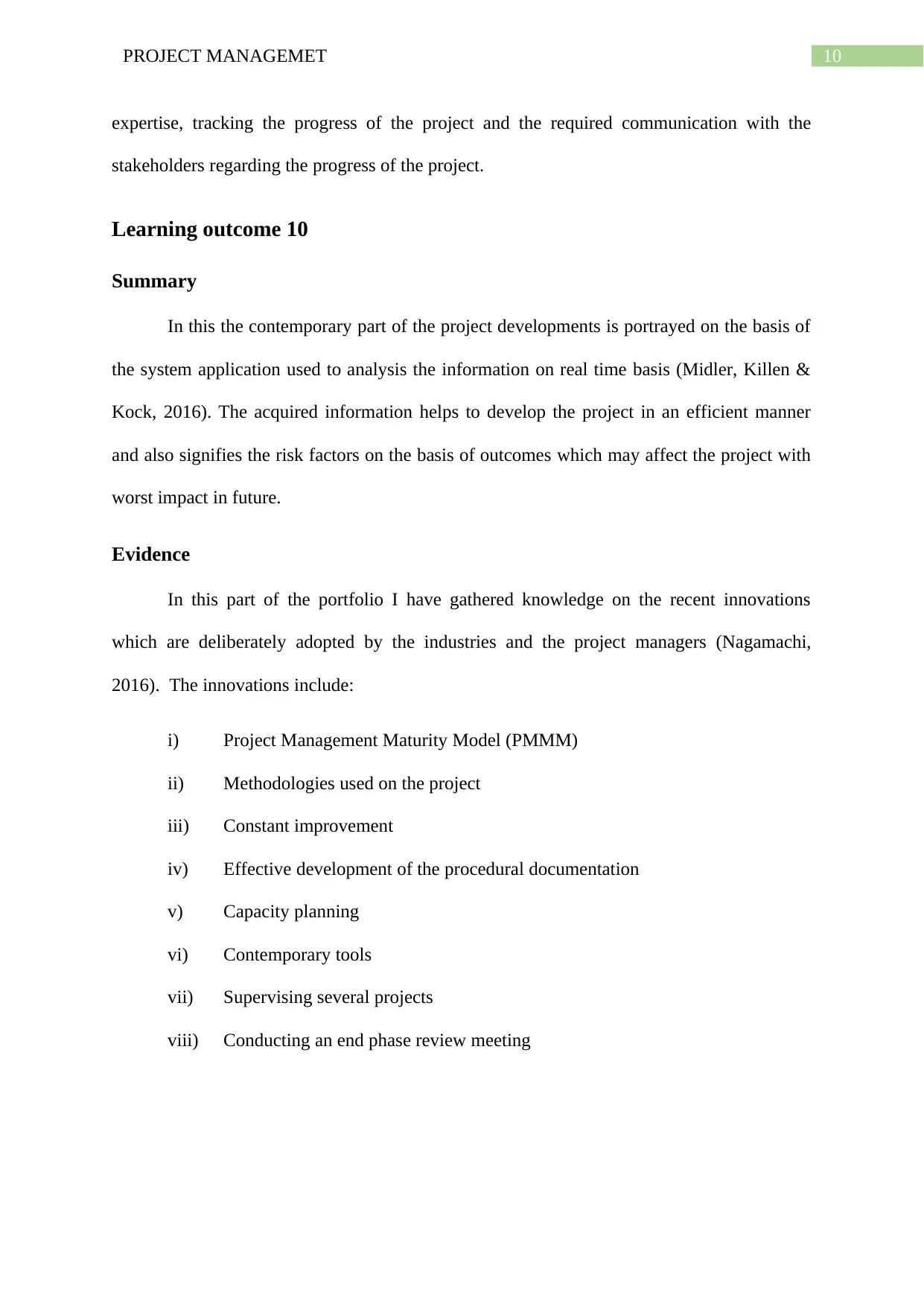
10PROJECT MANAGEMET
expertise, tracking the progress of the project and the required communication with the
stakeholders regarding the progress of the project.
Learning outcome 10
Summary
In this the contemporary part of the project developments is portrayed on the basis of
the system application used to analysis the information on real time basis (Midler, Killen &
Kock, 2016). The acquired information helps to develop the project in an efficient manner
and also signifies the risk factors on the basis of outcomes which may affect the project with
worst impact in future.
Evidence
In this part of the portfolio I have gathered knowledge on the recent innovations
which are deliberately adopted by the industries and the project managers (Nagamachi,
2016). The innovations include:
i) Project Management Maturity Model (PMMM)
ii) Methodologies used on the project
iii) Constant improvement
iv) Effective development of the procedural documentation
v) Capacity planning
vi) Contemporary tools
vii) Supervising several projects
viii) Conducting an end phase review meeting
expertise, tracking the progress of the project and the required communication with the
stakeholders regarding the progress of the project.
Learning outcome 10
Summary
In this the contemporary part of the project developments is portrayed on the basis of
the system application used to analysis the information on real time basis (Midler, Killen &
Kock, 2016). The acquired information helps to develop the project in an efficient manner
and also signifies the risk factors on the basis of outcomes which may affect the project with
worst impact in future.
Evidence
In this part of the portfolio I have gathered knowledge on the recent innovations
which are deliberately adopted by the industries and the project managers (Nagamachi,
2016). The innovations include:
i) Project Management Maturity Model (PMMM)
ii) Methodologies used on the project
iii) Constant improvement
iv) Effective development of the procedural documentation
v) Capacity planning
vi) Contemporary tools
vii) Supervising several projects
viii) Conducting an end phase review meeting
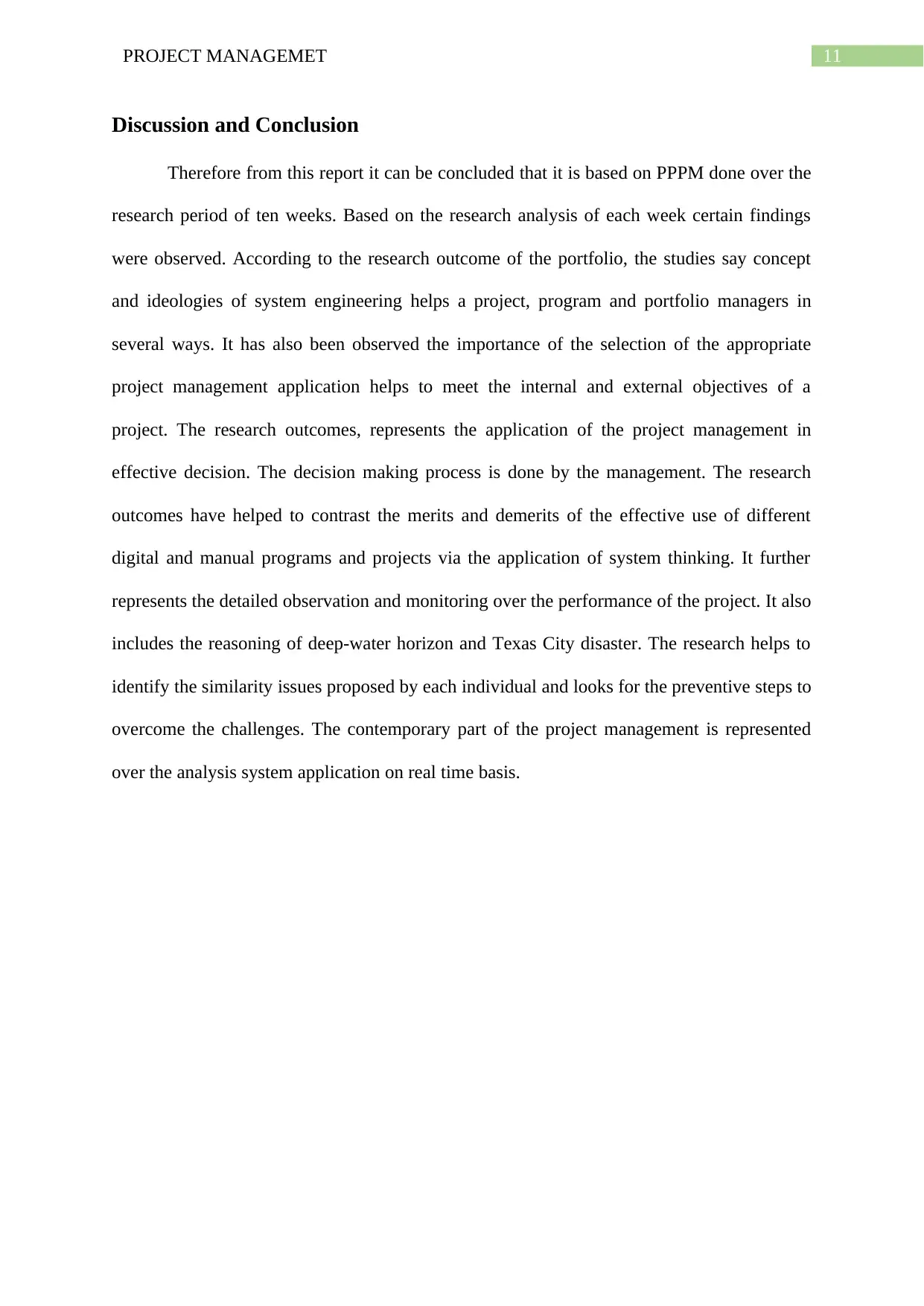
11PROJECT MANAGEMET
Discussion and Conclusion
Therefore from this report it can be concluded that it is based on PPPM done over the
research period of ten weeks. Based on the research analysis of each week certain findings
were observed. According to the research outcome of the portfolio, the studies say concept
and ideologies of system engineering helps a project, program and portfolio managers in
several ways. It has also been observed the importance of the selection of the appropriate
project management application helps to meet the internal and external objectives of a
project. The research outcomes, represents the application of the project management in
effective decision. The decision making process is done by the management. The research
outcomes have helped to contrast the merits and demerits of the effective use of different
digital and manual programs and projects via the application of system thinking. It further
represents the detailed observation and monitoring over the performance of the project. It also
includes the reasoning of deep-water horizon and Texas City disaster. The research helps to
identify the similarity issues proposed by each individual and looks for the preventive steps to
overcome the challenges. The contemporary part of the project management is represented
over the analysis system application on real time basis.
Discussion and Conclusion
Therefore from this report it can be concluded that it is based on PPPM done over the
research period of ten weeks. Based on the research analysis of each week certain findings
were observed. According to the research outcome of the portfolio, the studies say concept
and ideologies of system engineering helps a project, program and portfolio managers in
several ways. It has also been observed the importance of the selection of the appropriate
project management application helps to meet the internal and external objectives of a
project. The research outcomes, represents the application of the project management in
effective decision. The decision making process is done by the management. The research
outcomes have helped to contrast the merits and demerits of the effective use of different
digital and manual programs and projects via the application of system thinking. It further
represents the detailed observation and monitoring over the performance of the project. It also
includes the reasoning of deep-water horizon and Texas City disaster. The research helps to
identify the similarity issues proposed by each individual and looks for the preventive steps to
overcome the challenges. The contemporary part of the project management is represented
over the analysis system application on real time basis.
⊘ This is a preview!⊘
Do you want full access?
Subscribe today to unlock all pages.

Trusted by 1+ million students worldwide
1 out of 14
Related Documents
Your All-in-One AI-Powered Toolkit for Academic Success.
+13062052269
info@desklib.com
Available 24*7 on WhatsApp / Email
![[object Object]](/_next/static/media/star-bottom.7253800d.svg)
Unlock your academic potential
Copyright © 2020–2025 A2Z Services. All Rights Reserved. Developed and managed by ZUCOL.





